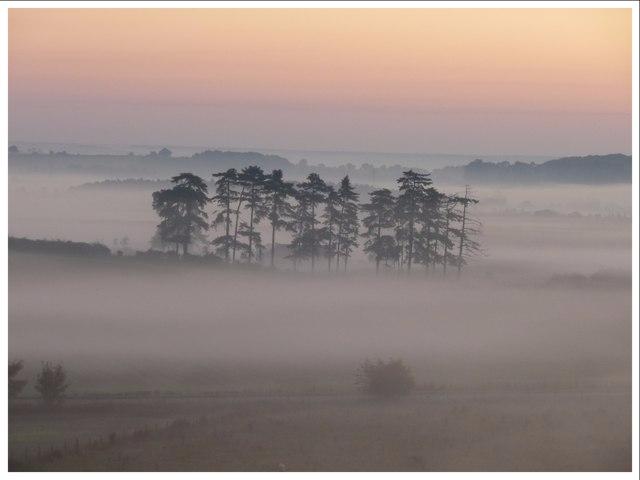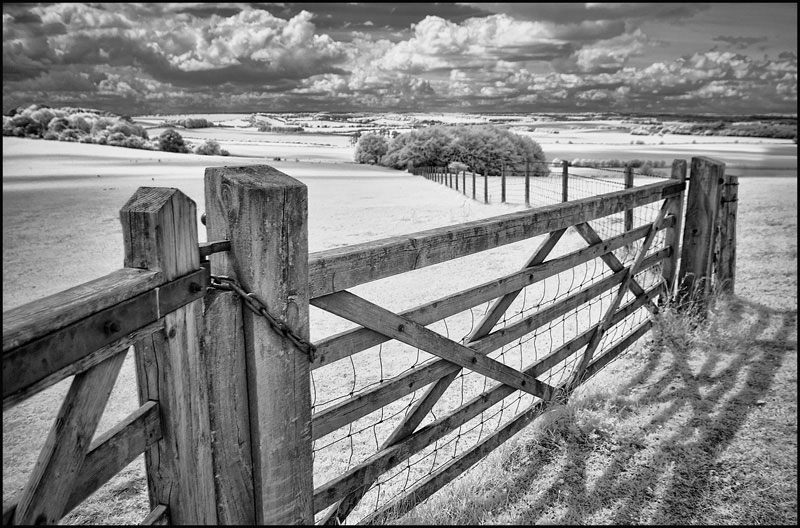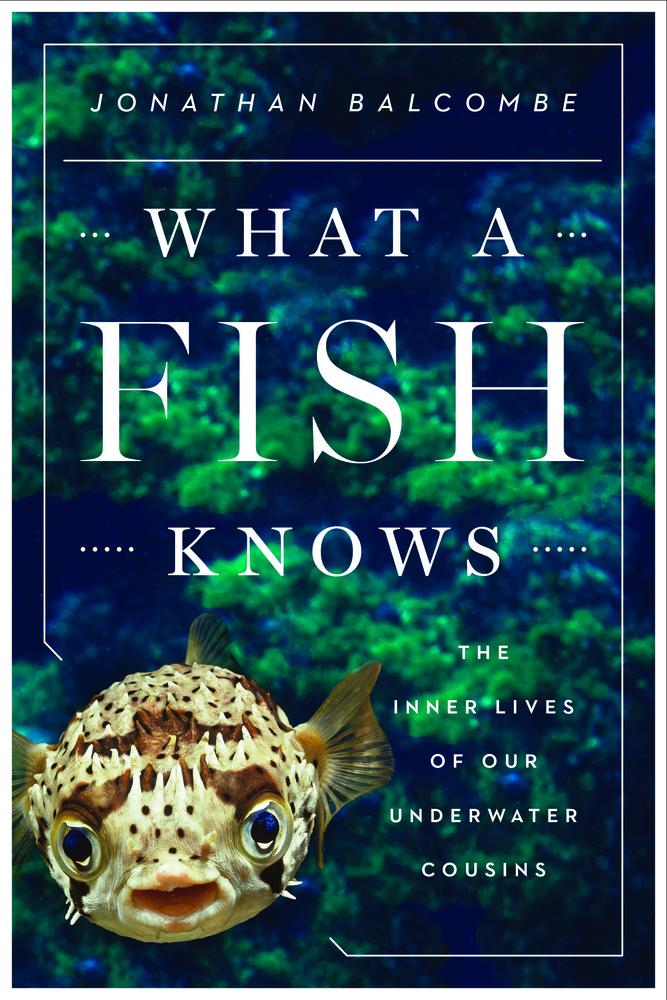Greetings!
By the
onset of dusk on Sunday I had had enough of being shrouded in mist; with the
exception of a glorious Wednesday us Wallopians have barely seen the sun for
two weeks. We rise to mist and go to bed to mist. It hangs around all day
gathering in ever increasing swirls of density to become fog as soon as the sun
starts to dip from its already feeble zenith. It is the shortest day on
Wednesday; it cannot come soon enough for me for it is the starting point
towards a new summer.
 But frankly by the time the
church clock chimed three I could not wait any longer; somewhere up there at
the far extreme of Nether Wallop is a much higher place, the hill they call
Danebury Ring. On a clear day you can spy the Isle of Wight from the top even
though it is 40 miles distant. At night red warning lights blink from
tall poles ushering the training helicopters from the nearby Middle Wallop
airbase away from catastrophe.
But frankly by the time the
church clock chimed three I could not wait any longer; somewhere up there at
the far extreme of Nether Wallop is a much higher place, the hill they call
Danebury Ring. On a clear day you can spy the Isle of Wight from the top even
though it is 40 miles distant. At night red warning lights blink from
tall poles ushering the training helicopters from the nearby Middle Wallop
airbase away from catastrophe.
Within a few
dozen paces of leaving The Mill the steep climb starts. In summer the footpath
is garlanded with daisies as it weaves you up a sloping field of shimmering
corn. Today it is rotting stubble. The path is starting to turn to mud. I
refuse to slacken my pace even though the incline starts to make me puff, so I
distract myself recounting in my head for the umpteenth time the disputed
origin of the suffix to the name of our village. Some say Wallop refers to the
family name of the Earls of Portsmouth, once mighty land owners around these
parts. Others say 'wallop' means hidden valley. As I breast the rise I turn to
see what I know I won't see; even on a clear day the village will already be
hidden from view. Today it snuggles under a white duvet.
Likewise
Danebury Ring is still nowhere to be seen but the route to it is marked by the
grass swathe that was once Stockbridge racecourse that gently rises away from
me into the distance for a straight 10 furlongs. I know it is a mile and a
quarter because today, even a hundred years after the last race was run, the
bouncy turf is training gallops to the local racing stable who have helpfully
laid out marker dollies. As I pass one the next looms up ahead, a vague form
hidden in the mist which slowly comes into sharper focus as I approach.
As I count each
passing marker the mist is definitely thinning until, without warning it
breaks. Whilst all behind me is clouded, ahead, in sharp relief, in bright,
clear air is the Iron Age fort we call Danebury Ring. I quicken my pace
to reach the summit ahead of the soon-to-set sun. I am not the first. Men
have been drawn to this place for seven thousand years or more. It is the
highest point for miles around. As an easily defended settlement it
pre-dates Stonehenge. The climb is harder than anything earlier so I do pause
for breath at the natural breaks as the hill, as prominent in this landscape as
a jelly mould on a table, rises then plateaus before rising again.
At the top I
marvel at the full circumference of the scene below me. In some respects it is
not so remarkable. The rolling, sheep-grazed chalk downs disappearing into the
mist. The spindly silhouette of the leaf-bare beech trees on a ridge so many
miles away that those colossal trees appear no higher than matchsticks at this
distance. No roads. No people. No buildings. The only colour is from the static
grey sky where breaks in the cloud allow for bright patches of the pinky-orange
setting sun to show through. The crows provide the soundtrack, swirling in
their hundreds beneath my feet as they caw-caw in incessant unison whilst
seeking out their night time roost.
Actually I am
wrong. It is remarkable. Because for thousands of years men have stood at the
very spot I am now and seen the very self same landscape. Heard the crows.
Watched the sunset. And like me shivered in anticipation of the chill hours ahead.
For this continuity we as a nation should be very proud. In a turbulent world
we still have on our doorstep some of the most amazing, beautiful and
unchanging landscape that remains, for me at least, a thing of great wonder.
But we stand at a threshold.
In my lifetime I
have seen the population of Britain rise from around 50 million to close to 70
million, most of the increase in the already densely populated parts of
England. Steel pylons have strung electric power cables across what we now call
National Parks. Motorways have obliterated villages. Where there were once
rivers there are now just boreholes. The sleepy market towns Pevsner celebrated
are surrounded by a mish-mash of development, a beleaguered hole in an ever
growing donut. Agriculture has long lost its way farming solar parks,
wind turbines and government subsidy. Where once we had communities we
have boroughs, or if you are really unlucky, a unitary authority. And industry
does whatever it chooses; the lure of jobs and taxes blinds all to any possible
downsides.
It is a horrible
triptych of urbanisation, industry and pollution that threatens what we hold
dear. Thirty years ago The Economist wrote tongue-in-cheek that no UK
government would rest easy until all of southern England was concreted over.
Sadly they may well be right. In our own way all of us recognise this, doing
our bit to fight the fight: recycling, green energy, eco cars, campaigning
where we see damage and misdeeds. I could go on, but you get the idea - it is a
long list of battles. But let us be honest we are fighting the symptoms of the
disease not the disease itself.
At some point,
if we wish to preserve what we hold dear, the time will come to call a
halt. No more new houses. No more roads. No more factories. No more of
the disease because the medicines will not work forever. Individual
communities, be they towns, villages , counties or whatever groups coalesce
around the cause should be entitled to say, accepting the consequences of that
decision, 'we are full'.
It was
completely dark by the time I made it back to The Mill to the welcoming warmth
and light of a home which made me think: is it the ultimate complacency of
entitled nimbyism to hold up the FULL sign to exclude progress to those that
follow me? I guess in a way it is. But then again progression assumes an
upwards path with a duty to nurture a better world for those that follow.
As a nation we need to realise that we stand at something of a crossroads. The
correct road to take is the hard-to-argue one. Whether we take it depends on a
collective will.

FISH HAVE FEELINGS TOO
 Jonathan's
Balcombe's book What a Fish Knows is a complex read. On the one hand it
is full of fascinating insights into the behaviour and lives of fish. How they
live, how they communicate, how they navigate their lives. Read it today and
you will, with little effort, be quite the bore over Christmas lunch.
Jonathan's
Balcombe's book What a Fish Knows is a complex read. On the one hand it
is full of fascinating insights into the behaviour and lives of fish. How they
live, how they communicate, how they navigate their lives. Read it today and
you will, with little effort, be quite the bore over Christmas lunch.
But on the other hand
Balcombe's book is a Crie de
Coeur for all fish. He firmly believes (and I am with him on this)
that fish should have equal rights to animals. But clearly they don't.
As he says of vegetarians
who eat fish they do it, 'as if there were no moral distinction between cod and
a cucumber'. This might be fine if we are treating our oceans with care, but we
are not. Ever increasing demand for fish allied with prodigiously efficient commercial
fishing fleets is gradually extinguishing sea life.
Balcombe wants us all to
stop eating fish now. See if you agree. Buy it on Amazon.
HAPPY
CHRISTMAS!
 We will be
shutting up shop for a few days over Christmas, but us fly fishers are a
restless bunch so it will not be for long. With the start of the new season now
closer than the end of the last this is the time to start planning.
We will be
shutting up shop for a few days over Christmas, but us fly fishers are a
restless bunch so it will not be for long. With the start of the new season now
closer than the end of the last this is the time to start planning.
If you had an opportunity to
read my last Newsletter you will know we have lots of new stuff for 2017 and
that the web site is loaded up, ready to go.
So, if you are happy to book
on-line it is all there for a few clicks of a mouse. That said should you
prefer a chat on the phone or like to ping a few emails back and forth we are
happy to help in any way.
Closed
December 23rd-27th
10am-4pm
December 28th & 29th
9am-1pm
December 30th
Closed
December 31st-January 2nd
9am-5pm
January 3rd
onwards
QUIZ
|
|
 |
|
|
Who am I?
|
You will notice a trend that
I am becoming something of a magpie. This week the questions come from What a Fish Knows.
1) What is the fish on the
right?
2) How many species of fish are
there in the world?
3) How many eggs does an Ocean
Sunfish carry?
4) How many million years ago
did the first fish evolve?
It's just for fun and answers are at the bottom of the
page. I will be back between Christmas and the New Year with 2016 in
Photos and the great 'Who's Fin is That?' quiz.
In the meantime from all of us at Fishing Breaks, and the fish as
well, have a very Happy Christmas.
Best wishes,
Simon Cooper simon@fishingbreaks.co.uk
Founder & Managing Director
Quiz answers: 1) Pufferfish
2) 33,249 and counting. 4 new sharks were discovered last year 3)
300 million 4) 530 million; homo
sapiens appeared 2 million years ago.

No comments:
Post a Comment